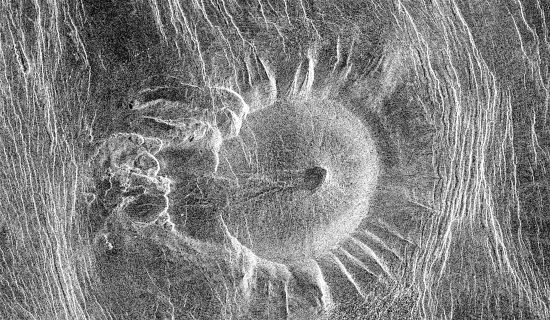
Eistla Regio on Venus. The corona is approximately 66 kilometers across at the base, with a slightly concave 35 kilometer wide summit. The sides are characterized by radiating ridges and valleys. Credit: NASA/Magellan C3-MIDR
Apr 17, 2017
Instead of tectonic activity, Venus shows signs of electric discharges.
The planet Venus shows signs of a somewhat recent catastrophe: giant cracks extend for hundreds of kilometers; formations called “coronae” are accompanied by massive fracture zones, branching out like carved lightning bolts; and vast caldera with upraised rims and glassified, crazed interiors dominate the landscape.
According to a recent press release, the coronae are said to occur because of subsidence caused by volcanic activity. Venus is also cut by “novae,” that extend radially from an area of parallel fractures. Planetary scientists identify those formations with volcanic upwelling. At some time in the past, magma partially melted and swelled the surface. When the magma subsided, the surface cooled and contracted, leaving behind a network of fractures. Similar processes are believed to form the coronae. However, in an Electric Universe, they resemble lightning scars called, Lichtenberg figures.
It is those features, in particular, that conventional science find most difficult to explain in the Venusian landscape. In previous Pictures of the Day, other interpretations would see electric discharge events.
Since one geological feature should not be viewed in isolation, along with coronae and novae are craters with wide, flat floors and steep sidewalls that are often terraced; sinuous canyons with vertical walls, scalloped edges, no outflow debris, and flat bottoms; mesas with forty-five degree “shoulders” and escarpments that are cut by parallel grooves; faults with no sign of strike-slip and with other faults cutting across them at ninety degrees are seen on Venus.
Shield volcanoes and pedestal craters result from gigantic plasma discharges, as well, since electric forces pull material toward the center of a vortex. After an electric arc passes, a raised mound of debris, often with a moat surrounding it, is left behind. Some of the raised mounds can be very large, such as in Eistla Regio on Venus.
Probably the most important aspect about Venus is an anomalous electric field, possessing greater force than accounted for by ordinary theories of planet formation. Electric Universe advocate, Wal Thornhill is sure that the raised mounds and the mountain tops on Venus are electrically energized:
“…diffuse electric discharge, known on Earth as ‘St. Elmo’s fire’, occurs preferentially at the higher altitudes of the mountains on Venus. In that thick atmosphere it forms a highly conductive dense plasma, which is a superb reflector of radar signals. The density of the atmosphere at the surface of Venus is about 1/10 that of water. St. Elmo’s fire is a highly ionised state involving actual discharge. Put the two together and you have dense plasma – which conducts like a metal and therefore reflects radar like a metal surface.”
This explains why some areas on the surface are so reflective to radar: St. Elmo’s Fire is a plasma phenomenon, similar to static electricity, and charged plasma reflects radar like a mirror.
How Venus was formed and how its blasted and burned surface came about must include electricity’s power. Its high density atmosphere generated highly energetic discharges that left deep trenches and structures called, “arachnoids” scattered across its surface. Plate tectonics does not account for all the unusual terrain on Venus. A better theory considers increased electrical activity throughout the Solar System in the recent past as a viable factor, accounting for the terrain, the electromagnetic field, the temperature variations, the polar vortices and many other phenomena.
Stephen Smith












